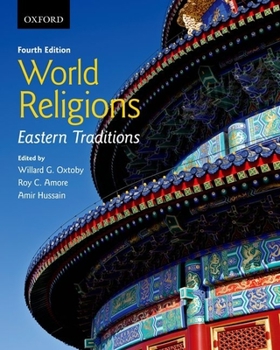World Religions: Eastern Traditions
Select Format
Select Condition 
Book Overview
Featuring work from expert contributors, World Religions: Eastern Traditions, Fourth Edition, provides students with an authoritative examination of Hinduism, Sikhism, Jainism, Buddhism, and Chinese, Korean, and Japanese religions. Accessible and engaging, this acclaimed text explores the origins, central teachings, divisions and branches, rituals and practices, influences on culture, and responses to modern challenges for each tradition. FEATURES...
Format:Paperback
Language:English
ISBN:0199002819
ISBN13:9780199002818
Release Date:March 2014
Publisher:Oxford University Press, USA
Length:412 Pages
Weight:1.79 lbs.
Dimensions:0.9" x 7.9" x 9.9"
Customer Reviews
2 ratings
Satisfied
Published by Thriftbooks.com User , 16 years ago
Well this book has truely been beneficial to me since I ordered it. I didn't really want to create an account with this website but after purchasing this book, I'm thinking that I'll probably order more items. I just want to thank the seller for her honesty. Everything was just as she said it would be. Now doing my paper won't be so tedious since I have the book handy.
A good survey of Eastern religions
Published by Thriftbooks.com User , 20 years ago
There is no such thing as a completely unbiased and objective text on religious studies. As other commentators on this volume have noted, there are some definite biases in this volume, but one must also allow for biases on the part of the readers, too. This book, edited by Willard Oxtoby of the University of Toronto, is the kind of book often used for introduction to world religions courses. This is part of a two-volume set; this volume deals with the major religions to come out Asian continent, as well as a few lesser-prominent traditions, such as Pacific Island religious varieties. In his introduction, Oxtoby addresses the issue of objectivity and the insider/outsider consideration about religious studies writing. The other authors, Vasudha Narayanan, Julia Ching and Roy Amore, write of Hindu and Buddhist traditions respectively, and while Oxtoby is a Christian, he writes on the subjects of the Sikh, Asian/Pacific, and general topics in the text. Narayanan also writes on the Jainist tradition, while Ching writes on less prominent East Asian religions, closer in affiliation with their own traditions than a Western academic like Oxtoby. We are not given the specifics of denomination or sectarian affiliation here, but given the purpose of writing broadly-useful texts, such classifications might hinder rather than help progress. There are major chapters on Hindu, Sikh, Jain, Buddhist, East Asian, and Asian/Pacific religions, in addition to a general chapter looking at the nature of religion in philosophical and social science terms. Each chapter incorporates history, particularly the beginnings of the religions, and the fundamental belief structures. For each major faith, a description of the current state of affairs is also included. There are photographs throughout, but not so many for a 500+ page book. There are maps, diagrams and charts relating to the subjects. Perhaps the most useful are the highlighted text boxes, which often draw into greater relief key scriptures, historical events, personalities or ideas -- given the difference in languages, most chapters conclude with a glossary of key terms. Pull-boxes can include information such as scriptural citations (Bhagavad Gita, Dhammapada, etc.), prayers and liturgical pieces, or snapshot descriptions of key issues. The concluding chapter on the nature of religion develops ideas from the philosophy of religion, the sociology and pscyhology of religion, as well as a general overview synthesis of key areas of similarity. Given that the bulk of the two volumes discusses the particularities of the religions of the world, a few pages on the similarities and shared elements is welcome. Oxtoby writes that, 'if there is one common denominator among the religions, it is humankind. Human action, human thought, and human devotion.' Well said. Each major section begins with a timeline of key dates in the development of that tradition. Each section concludes with lists for further reading, r






